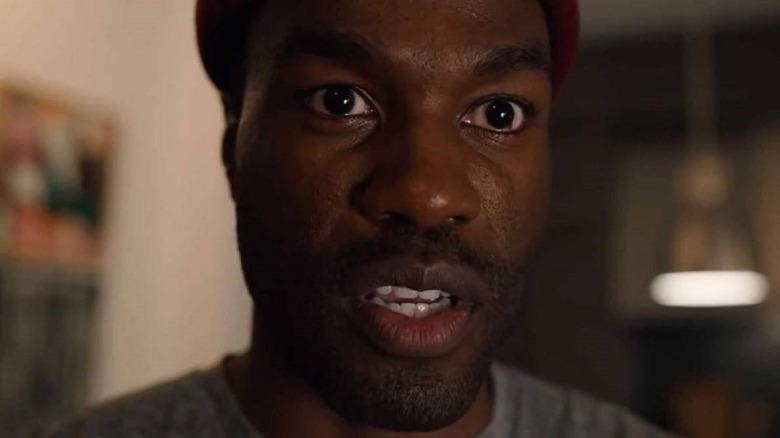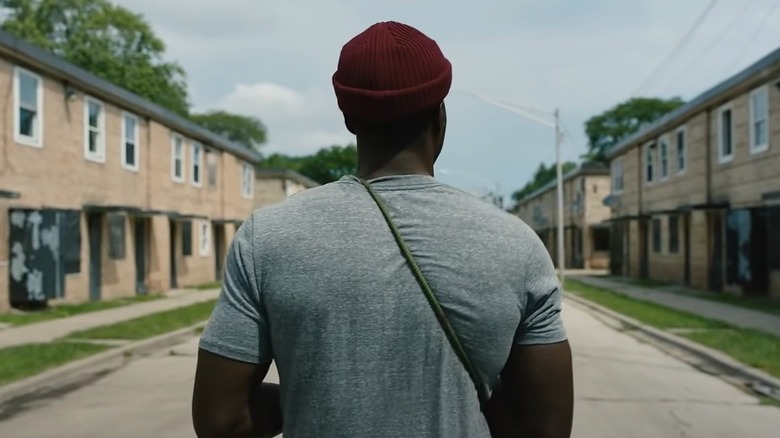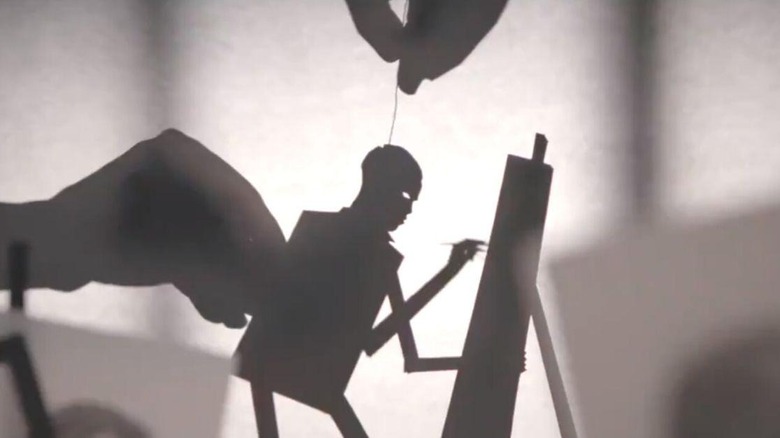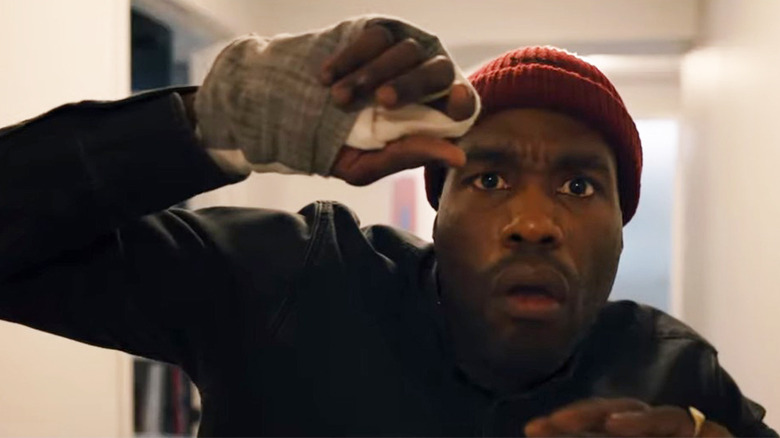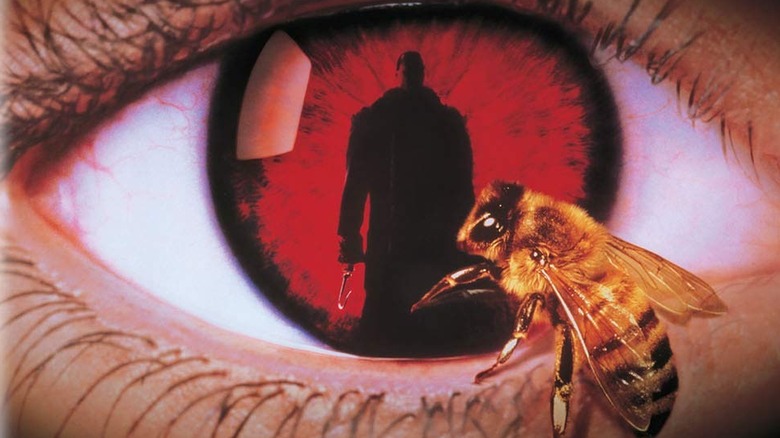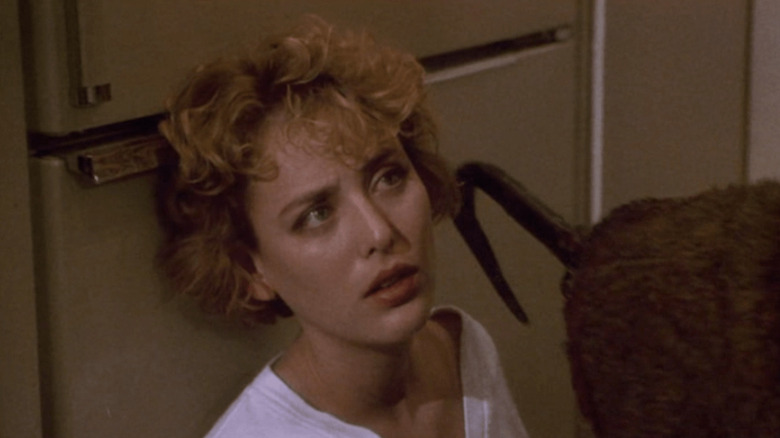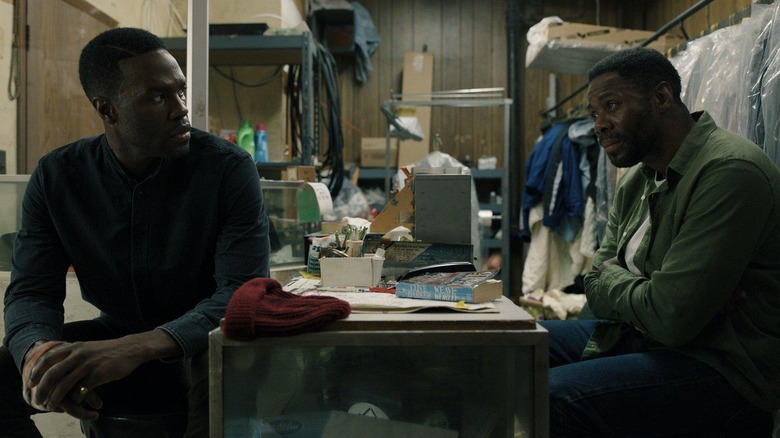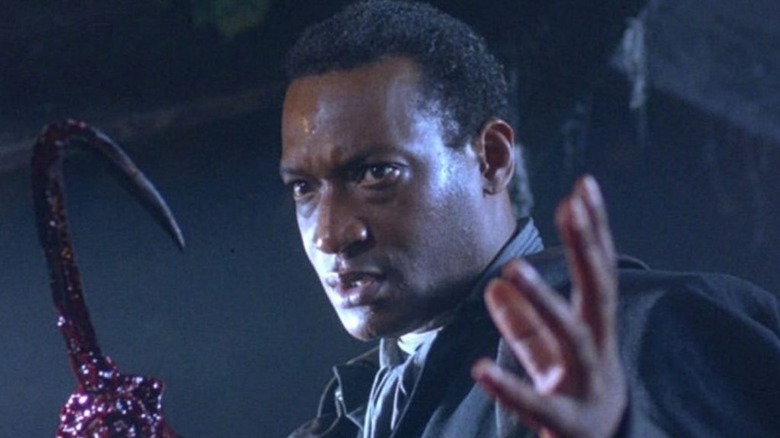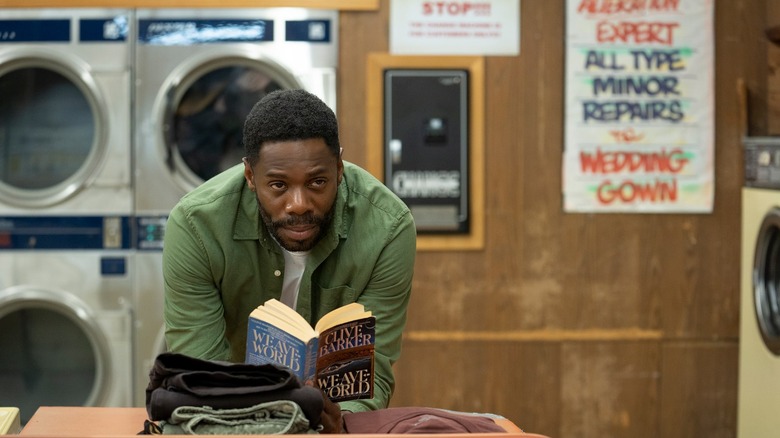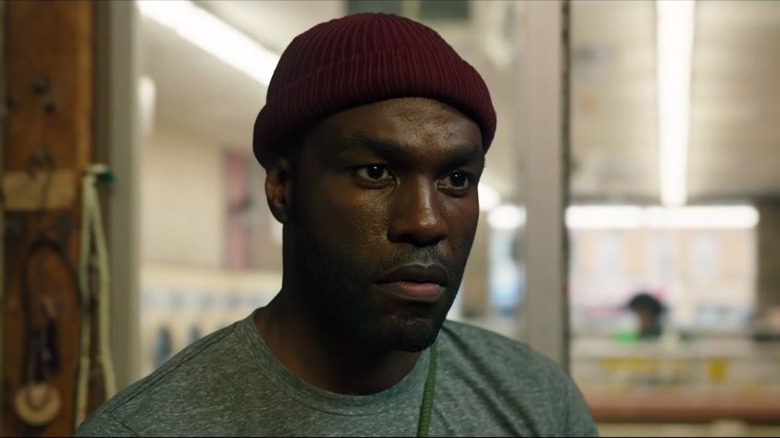Every Reference To The Original Candyman Made In The Reboot
It isn't being marketed like one — which is probably a good thing — but Nia DaCosta's new "Candyman" movie is more or less a sequel to the original 1992 social commentary slasher. Both DaCosta and co-writer/producer Jordan Peele are big fans of Bernard Rose's "Candyman," and their reboot is a loving homage full of references and story beats that build off the plot of the original. This is truly the second coming of Candyman, and he might just be here to stay.
Say his name five times in the mirror, and Candyman — a man wearing a large coat, surrounded by buzzing bees, with a bloody hook for a hand — will appear. The concept itself is chilling. And the inherent terror isn't lost in the new "Candyman," but the movie spends a lot of time calling back to its origins. What follows are all the references DaCosta's "Candyman" makes to its progenitor and all the key moments of lore explained.
Warning — there are spoilers below.
The new Candyman returns to Cabrini Green
The setting in the new "Candyman" is the same as the original film, yet it represents an extremely different social class, which plays directly into what this movie is about. The first "Candyman" is about a white grad student's exploration of the Candyman legend through interviewing local residents of Cabrini Green, the housing project where the rumors of Candyman's killing are gospel. The 2021 reboot returns to Cabrini, but instead of a run-down housing complex, we're shown an opulent, modern apartment complex.
This speaks to how DaCosta and Peele's "Candyman" is tackling gentrification as a main theme. It's also true to life. Cabrini Green's projects were demolished throughout the late '90s and early 2000s, and in the past decade, high-rise apartments have been put up. Real-life gentrification at the setting of the original film itself served as an inspiration for where to take the new one.
The Shadow Puppet sequences recap the first movie's plot
The latest entry in the franchise recaps much of what happens in the 1992 original. But instead of simply having a character explain to Anthony the events of the first film — in most cases, that honor belongs to local victim of Candyman trauma William Burke — DaCosta's "Candyman" decides to convey a lot of background info with a sense of style through its fantastic shadow puppet sequences.
Before Burke's scenes, an early shadow puppet sequence is used to illustrate a ghost story that Brianna's brother, Troy, is telling, one that sets up the legend of Candyman. Interestingly, this sequence focuses on the story of Helen Lyle, the protagonist of the first film. He tells how she ventured into Cabrini Green for her thesis, but then, it becomes evident that Helen's tale has changed and grown a bit over the years, and now, she's viewed as the monster responsible for Candyman's crimes in the original movie.
But the background info doesn't stop there. The first scene where Burke explains Candyman to Anthony recaps much of the first half of the original film — absent Helen's story — and gives the character and audience the background on the police murder of Sherman Fields, who many believed to be behind the Candyman murders of the 1990s.
Anthony's bee sting is a huge symbol
Oh, no! Not the bees. Yes, if you signed up for "Candyman," you best believe there will be bees. But the first bee of the film comes up in a more subtle and symbolic fashion than most of the references in the reboot.
When Anthony first explores the abandoned neighborhood that used to be low-income housing, he sees a broken down church and compares it to the photo depicting it full of life from merely 30 years before. It's then that the bee comes to sting him on the hand. Thus begins the grotesque decaying of his limb, foreshadowing his eventual need for the legendary hook.
The significance of this moment bears fruit by the end, but in the moment, it's a nod and wink to any fan of the original, suggesting the transformation to come. The bee swarm and the hook hand are the two iconic features of the Candyman character. In fact, this movie pushes the idea of multiple Candymen inhabiting one "hive" body, as it were, expanding the bee metaphor even further beyond even the source material.
Those frequent shots of Anthony's eyes are very clever references to the 1992 poster
Starting after he is stung by the bee, we are often shown close-up shots of Anthony's eye. His eye begins to turn more crimson, with a black splotch growing on the edge of the iris. These images are explicit call backs to imagery from the 1992 "Candyman," specifically the most famous poster released for the movie.
While it looks like just a red iris, if you look closely at the original "Candyman" poster, you can see the pupil is shaped in the outline of Candyman. And perched on the eyelid is a bee. As Anthony starts to see himself in the mirror and recognizes that he's becoming Candyman, his eye changes. The black splotch that develops is in the same location as the bee on the classic poster, another way the modernization ties these symbols together.
Virginia Madsen makes a cameo ... sort of
A "Candyman" movie wouldn't be a "Candyman" movie without Tony Todd, and the franchise has stayed alive on the coattails of that first movie's perfect casting choice. While Vanessa Williams also returned to reprise her role as Anne-Marie (baby Anthony's mother), one star who didn't come back was Virginia Madsen. Despite being rumored to return, she only appears in recycled footage from the 1992 film and doesn't make an appearance in the present-day timeline. Which makes sense ... considering where she ended up when credits rolled in 1992.
However, when Anthony is doing research on Candyman in the library, he uncovers a file from Helen's investigation. A brief shot of the folder shows a headshot of Virginia Madsen as Helen Lyle from the 1992 movie. We also hear Madsen's voice-over ripped from that movie and placed over a montage of Anthony continuing to read up on the case.
Burke's name is an interesting reference the original horror flick
In the first "Candyman" film, Helen Lyle is arrested for the murder of her friend, Bernadette Walsh, and meets with a psychiatrist while she waits to be put on trial. The doctor who speaks to Helen in this scene is named Dr. Burke, meaning the Burke in the reboot is definitely a reference to this character. In the 1992 version of "Candyman," Burke is swiftly killed by the titular slasher not long after he's introduced, but the Burke in DaCosta's movie plays a much larger role. This is a great little Easter egg, but in the first movie, Burke isn't nearly as much of a fleshed-out character as his namesake in the new entry. However, both characters are coincidentally the last kills in their respective movies before the protagonists (Helen in 1992, Brianna in 2021) eventually side with Candyman.
The origin of the Candyman is explained
There's one final short animated sequence near the end of the film (Burke and Anthony's last interaction before he goes full Candyman) where Burke explains the origin of the terrifying legend. It began with a man named Daniel Robitaille, a slave that, once freed, gained success and influence as a portrait artist in the late 1800s.
Robitaille was caught having a sexual relationship with a daughter of a wealthy white lord. As punishment for his act, a mob was sent after him, and it was here that the legend began. The men cut off Robitaille's hand and smeared him in honey so bees would sting him to death. But all that and tossing him on a burning pyre couldn't stop his vengeful spirit from coming back and claiming revenge as the original Candyman. In director Bernard Rose's original, this scene is depicted in a brutal flashback full of incredible period-appropriate attire.
Burke is reading a Clive Barker novel, a reference to the story Candyman is based on
If you look closely in a couple of the scenes with Burke in the laundromat, you can see he's reading a book. And, of course, because Jordan Peele was involved with the script, no little detail can be assumed to be innocuous. Naturally, the book Burke is reading is a deep reference to anyone familiar with the origins of the story that Bernard Rose turned into "Candyman" in the early 1990s.
Burke is reading "Weaveworld," a dark fantasy novel by famed horror writer Clive Barker, who not-so-coincidentally wrote the short story "Candyman" is based on. "The Forbidden" was published in 1985 and served as the inspiration for the film series. Barker — also the man responsible for "Hellraiser" — most likely based Candyman on the tale of Bloody Mary, but he also infused a layer of modernity into the urban legend. "The Forbidden" is where the imagery of the bee-infested monster with a hook hand comes from as well, but the illustrations that were printed alongside the story are distinct from Tony Todd's iconic look — presenting more of a wild monster than Todd's classy yet scary appearance.
As for the novel Burke is reading itself, "Weaveworld" is about a hidden world inside a tapestry, bringing to mind the two worlds on each side of a mirror that DaCosta's "Candyman" so often depicts. This Easter egg was definitely chosen with care.
Anthony is the baby Candyman abducted in the first movie
This one is not only obvious, but it's the plot beat the entire story hinges on. It's the ultimate bit of inarguable connective tissue between the two films — the fact that Anthony was the baby kidnapped by Candyman in the first film.
The final twist confirms 2021's "Candyman" as a sequel to the original, using the building blocks to establish something fresh. Near the end of the movie, we see Anthony go to his mother. Vanessa Williams returns from the first film to reprise her role as Anne-Marie, and if that didn't give the reveal away, then nothing could. Still, the fact that Anthony is the baby from the first "Candyman" isn't treated like a twist because, despite extensive screen time being spent to explain it, most viewers will know by now what's going on.
In fact, if you were to watch 1992's "Candyman" before going to theaters to see the new one, you'd easily be able to pick up on the character names. To many fans, this moment isn't even a twist, especially as Anthony's dark transformation becomes more and more inevitable.
